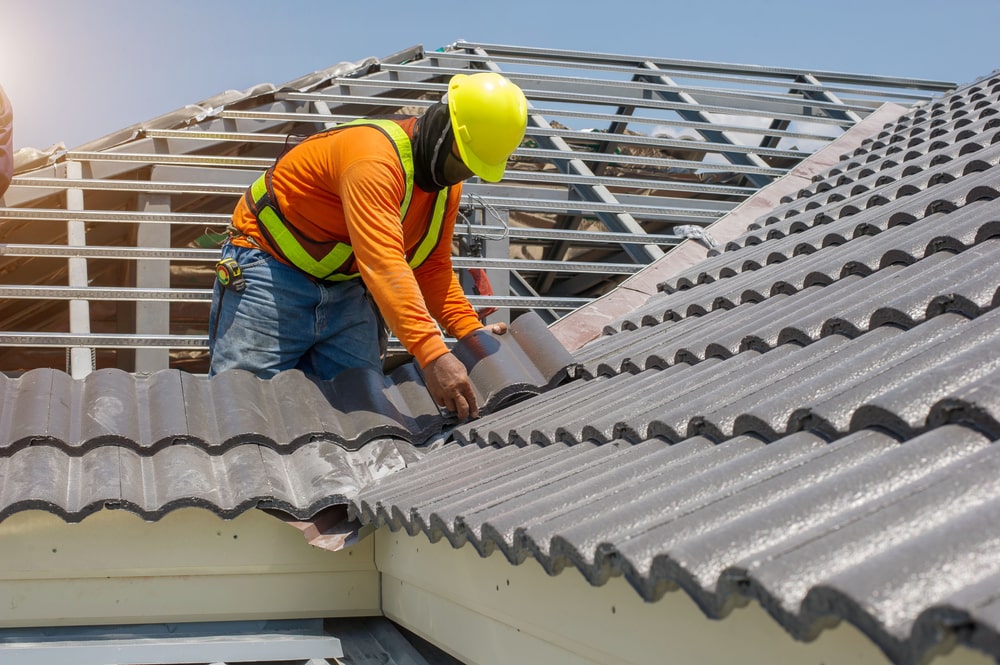Just How Gainesville Roofing Companies Can Transform Your Home's Outside
Just How Gainesville Roofing Companies Can Transform Your Home's Outside
Blog Article
Best Practices for Ensuring Proper Roof Air Flow
Making certain proper roofing ventilation is essential for the durability and performance of a roof. A well balanced consumption and exhaust air vent proportion, commonly 1:300, plays a pivotal duty, with consumption vents preferably placed at the lower edge of the roof covering for great air entry and exhaust vents at the height for cozy air exit. Routine examinations to determine obstructions and maintain clear air movement are extremely important. Keeping insulation away from vents is important to avoid air movement constraint. Understanding these fundamental components establishes the stage for even more detailed insights into installation and upkeep methods that can significantly enhance your roofing system's efficiency.
Understand Air Flow Fundamentals
Appropriately recognizing air flow fundamentals is necessary for making sure the long life and efficiency of roof covering systems. Efficient air flow alleviates dampness build-up and temperature level extremes in the attic room, both of which can cause substantial structural damages gradually. A well-ventilated roofing system aids in avoiding typical concerns such as mold growth, wood rot, and ice dams, which can jeopardize the integrity of the roofing products and the underlying structures.
The main objective of ventilation is to assist in the motion of air, permitting for a regular exchange in between the indoor and exterior settings. This equilibrium is achieved via a combination of consumption and exhaust vents that interact to keep ideal air flow. Intake vents, normally situated along the eaves or soffits, allow fresh air to enter the attic room room, while exhaust vents, frequently positioned at or near the roof covering ridge, enable hot, moist air to escape.
Key variables influencing the efficiency of roofing air flow include correct positioning, adequate sizing, and ensuring that both consumption and exhaust vents are unhampered. Routine assessment and upkeep are important to determine possible clogs, damages, or ineffectiveness in the ventilation system, consequently securing the roofing's efficiency and sturdiness.
Kinds Of Roof Covering Vents
Roofing system vents play a critical role in maintaining reliable attic room air flow and, by expansion, the overall wellness of the roof covering system. Numerous kinds of roofing system vents are offered, each with special benefits customized to particular roof needs. Ridge vents, as an example, are mounted along the roofing system's height, allowing cozy, moist air to get away from the attic room. They offer continual air flow and blend effortlessly with the roofline, making them both reliable and visually pleasing.

Soffit vents are installed under the eaves and operate in tandem with roof covering vents to make certain a well balanced intake and exhaust system. By permitting cooler air to get in from below, soffit vents facilitate the expulsion of warm air with upper vents. Gable vents, located on the outside wall surfaces of the attic room, offer an additional effective service, specifically in homes with gable roofing systems.
Assess Your Existing Air Flow

Next, take into consideration the age and condition of your roofing materials and ventilation parts. Older systems might not adhere to existing building ordinance or may have degraded over time, reducing their performance. Conduct a complete exam to determine any type of indicators of wear and tear, such as corrosion, damage, or gaps that can jeopardize Continued the system's performance.
Furthermore, determine the attic room temperature level and moisture degrees. High temperature levels and moisture can suggest inadequate ventilation - roofing companies in gainesville florida. Use a hygrometer and thermostat to get exact analyses, contrasting them with outside conditions. Relentless discrepancies recommend possible problems that require dealing with.
Setup Best Practices
Effective installment of roof air flow systems is paramount for guaranteeing optimal sites performance and durability. Appropriate setup begins with understanding the details air flow needs of the roofing system and the building it covers. This entails determining the proper ratio of consumption to wear down vents, normally sticking to the 1:300 rule, which states one square foot of ventilation for each 300 square feet of attic flooring space.

The placement of vents is similarly crucial. Consumption vents need to be installed at the roofing's reduced side, frequently in the soffits, to enable cool air to get in. Exhaust vents, on the various other hand, should be set up near or at the roofing system's top to assist in the leave of cozy, wet air. This develops an all-natural air movement that aids keep temperature and dampness equilibrium within the attic space.
Seal all air vent links carefully to stop air leakages and potential water seepage. Use high-grade products and adhere to maker guidelines to make sure longevity and efficiency. Additionally, integrating ridge vents with baffles can considerably improve air movement effectiveness by preventing wind-driven rain and snow from getting in the attic room.
Inevitably, precise installment of roof covering air flow systems minimizes prospective issues such as mold development, ice dams, and structural damages, making sure the roof's stability and the structure's overall wellness.
Normal Maintenance Tips
Consistency in upkeep techniques is basic to guaranteeing the long-lasting performance of roof covering air flow systems. During these assessments, ensure that vents are cost-free of particles, nests, and other blockages that might restrain airflow.
Use a soft brush or a vacuum to eliminate dirt and particles look at this web-site from consumption and exhaust vents. Be cautious not to damage the air vent displays or louvers during the process.
Correct insulation is equally crucial. Make certain that attic room insulation does not obstruct the vents, as this can drastically restrict air flow. If any type of insulation has changed or settled, reposition or replace it to keep an efficient barrier.
Finally, change any type of damaged or missing elements immediately. Damaged vents, split tiles, or scrubby blinking can all contribute to inadequate air flow and needs to be dealt with right away. Routine maintenance guarantees that the roof covering ventilation system operates optimally, thereby extending the lifespan of the roof covering itself.
Conclusion
Making certain correct roofing air flow is vital for preserving the effectiveness and toughness of a roofing system. Adherence to the 1:300 intake and exhaust air vent ratio, coupled with the tactical placement of vents, is important.
A well balanced intake and exhaust air vent proportion, commonly 1:300, plays a pivotal duty, with intake vents preferably placed at the reduced edge of the roofing system for amazing air access and exhaust vents at the height for cozy air exit. Consumption vents, typically situated along the eaves or soffits, permit fresh air to get in the attic space, while exhaust vents, often situated at or near the roof ridge, enable hot, moist air to leave.
Soffit vents are installed under the eaves and job in tandem with roofing vents to make certain a balanced intake and exhaust system. By allowing cooler air to get in from below, soffit vents help with the expulsion of warm air with upper vents. Adherence to the 1:300 intake and exhaust air vent proportion, paired with the strategic placement of vents, is crucial.
Report this page